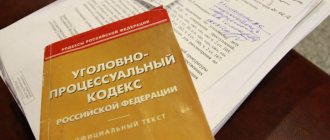Concept, characteristics and functions
The term “procedural documents” is quite capacious and meaningful in meaning. Let's consider several different formulations of this concept:
1. Procedural documents are acts of implementation of legal norms that ensure compliance with legal behavior on the part of subjects of civil legal interaction.
As an act of execution of legal norms, a procedural document has a number of distinctive features:
- is a form of expression of any action or decision on the part of government bodies or authorized officials;
- carries within itself a state will that requires strict observance and execution;
- assumes a special form regulated by law;
- implies the personalized nature of regulation of civil legal relations.
2. Procedural documents are outgoing materials provided by participants in legal relations (state bodies, officials, legal entities, individuals) in the process of legal proceedings.
Procedural documents, being an integral part of any legal relationship, perform a number of important functions:
- Informative - consists of the content of the necessary information about persons, things, events, acts that have legal significance.
- Identifying – presupposes the presence of certain attributes, details that justify the legal force of the act, as well as defining the information contained therein.
- Law enforcement – organizes the execution of documented legal norms within the framework of a specific civil legal case.
- Security and protective – consists of ensuring the safety of important information, implementing protective measures to maintain its reliability and safety.
- Operational – involves the possibility of using and transmitting information by subjects of legal relations.
3. Procedural documents are special forms of recording the actions and decisions of subjects of legal relations, allowing to track the proceedings of court cases.
Classification of procedural documents
First of all, it is necessary to find out what procedural documents exist within the framework of the legislation of the Russian Federation. Experts identify several different classifications.
Based on one of them, all procedural acts are divided into two large groups:
- pre-trial significance;
- judicial acts.
According to their functional purpose, acts of registration and execution of legislative norms are divided as follows:
- statements (appeals);
- protocols;
- regulations;
- complaints;
- executive documents;
- protests;
- petitions.
The main types of procedural documents are divided according to the law. Among them are:
- Civil procedural documents that provide legality in civil cases.
- Materials compiled in arbitration proceedings.
- Administrative procedural documents that guarantee the legality of administrative cases.
- Acts affecting constitutional norms.
- Criminal procedural documents that relate to ensuring the rule of law in criminal cases.
The enforcement form may be:
- regulatory, based on the application of legal norms and aimed at the effective regulation of various lawful acts;
- law enforcement related to the implementation of legislative sanctions of a preventive and punitive nature.
Procedural materials are also divided into several types based on their structure:
- Acts consisting of four parts: introductory, descriptive, motivational, operative (decision, sentence).
- Acts with three parts that do not include a motivational part.
- Acts in two parts: introductory and operative.
- Acts containing only a decision.
According to their legal purpose, court procedural documents are divided into two categories:
- Basic. This type of material contains a fully completed solution regarding a specific legal case.
- Auxiliary. These are procedural documents that set out preliminary information and instructions aimed at preparing the main legal acts.
Requirements for the preparation of court documents
Judicial procedural documents are materials emanating from the court. These include: decisions, rulings, court orders, protocols, acts drawn up in order and executive format.
The structure of court procedural documents consists of four subsections:
- Introductory. It records the name, address of the judicial organization, the time period for making the decision, the composition of participants or legally interested persons, and the subject of the case is approved.
- Descriptive. Contains indications of the conditions and circumstances of the situation, includes demands and objections of subjects of legal relations and other interested parties, including facts justifying these protests.
- Motivational. Reflects the factual and legislative justification of a court decision on a procedural act. This part may be mandatory, or may be included at the initiative of the court.
- Resolute. Involves recording the final decisions of judicial debates, final conclusions that resolve the essence of the case.
Judicial decisions are made immediately upon completion of the proceedings. The operative section of the decision is read out in the same court where the results of the case were summed up. The delivered and heard part of the decision must be certified by the signatures of all judges and attached to the case.
The following requirements are imposed on the court decision:
- legality;
- validity;
- justice.
The execution of a reasoned court decision should not exceed five days from the completion of the proceedings in the case.
Features of documentation in civil cases
The main task of civil judicial proceedings is to ensure the protection of the rights and freedoms, interests of civilians, organizations and other participants in legal relations. According to Article 2 of Part 1 of the Code of Civil Procedure of the Russian Federation, every citizen has the right to appeal to a court in the event that his rights and freedoms are violated. The form of application to protect one’s interests in court is a statement of claim. The preparation of this document is strictly regulated at the legislative level. If necessary, samples of procedural documents can be found in the Civil Procedure Code of the Russian Federation.
Among the requirements for drawing up a statement of claim are the following:
- Fixing the name of the judicial institution where the document is submitted.
- Indication of the personal data of the defendant (full name, residential address).
- Description of the subject of the violation or the presence of a threat of violation of rights, as well as the presentation of demands.
- Disclosure of circumstances that are evidence of the specified facts of violation.
- Availability of evaluative characteristics, if necessary (collected, disputed amount of money).
- Indication of the list of attachments to the application.
This act cannot be drawn up in free form, so the help of specialists is often required.
Procedural documents of an administrative nature
In the production of procedural documents in administrative cases, there are four main groups:
1. Decisions made by authorized bodies related to intermediate stages of the process:
- initial (protocols on administrative offenses), from which legal cases begin;
- interim (decrees to conduct an examination), describing the subsequent development of cases;
- final, including final decisions at certain stages and based on the results of the procedure as a whole.
2. Materials sent from other participants in procedural cases or addressed to government bodies: statements of claim, complaints, petitions.
3. Documents confirming conclusions on certain legal actions that serve as the basis for evidentiary information (protocols of inspections, interrogations).
4. Technical and information documentation (inventory, presentation).
Procedural documents of administrative proceedings include:
- explanations of persons involved in the process (suspect, victims, legal representatives), presented in writing;
- motions or challenges;
- various complaints (against decisions in the case, decisions made, results of consideration of complaints), etc.
Documents related to acts of an executive nature and directly related to judicial proceedings can be drawn up in the form of an application. It is submitted either to bailiffs or directly to the court.
Criminal procedural documents
Thus we got closer to the criminal case. It should be noted right away that there is no clear definition of the term “procedural documents” in criminal law. However, the documents themselves provide regulations regarding their form and content.
Criminal proceedings materials have different names. For systematization purposes, procedural documentation of a criminal nature is divided into two large groups:
1. Information and identification card. Represents acts that implement the interaction of authorized bodies and officials with other parties to the legal process. These include various types of instructions, instructions, requirements, subscriptions, obligations, explanations, etc. The following subgroups are distinguished here:
- acts ensuring interaction between the parties to the trial, as well as the exercise of powers of representatives of government agencies;
- protocols of investigation and judicial proceedings, consisting of the collection, study, verification, analysis of evidence;
- protocols of other procedural acts.
2. Powerful and administrative. Contains decisions of authorized government officials and officials acting in criminal trials. These include:
- sentences, rulings, court decisions;
- representations from investigative and investigative structures, prosecutors, judges;
- private judicial determinations and requirements;
- indictments;
- jury verdicts.
Comments
It is worth noting that the most common procedural papers are documents of the second group. They record the process and results of procedural activities. We are talking about protocols. So, protocols of judicial and investigative actions are procedural papers in which certification of the fact of production, content and corresponding results of judicial and investigative actions is relevant. Thus, it is customary to distinguish between the interrogation protocol, the crime scene analysis protocol, the court hearing protocol, and so on.
Main types of procedural acts
When conducting preliminary work on criminal cases, a large number of various types of documentation are compiled, which can be either mandatory or optional. Mandatory acts are drawn up for any criminal trial by the investigative committee. They include decisions on certain issues arising during the investigation, indicating evidence and conclusions. The main procedural documents of the investigator include protocols, resolutions, and indictments.
Auxiliary or optional documents are those of a non-binding nature, which are drawn up depending on the specific criminal proceedings. This type of act is represented by notices, subscriptions, instructions, objections, subpoenas, etc.
Types of solutions
Next, it is important to consider the classification of such procedural documents of production as decisions. In the theory of criminal procedural law, it is customary to distinguish the following types of decisions:
- Resolution. A ruling should be understood as any decision (with the exception of a sentence) made by a single judge. In addition, this is a decision that was made by the judicial presidium in the process of reviewing a court decision that has already entered into force in accordance with the law. A resolution is a decision of the prosecutor, investigator, management of the investigative structure, or investigator, which was made during the preliminary investigation of the case. It is important to note that the exceptions in this case are indictments and conclusions.
- Definition. The definition should be considered any decision (exception - sentence) made by the judicial authorities of the first instance in the process of criminal proceedings collectively. In addition, we are talking about a decision made by higher judicial authorities (with the exception of a supervisory or appellate court) in the process of reviewing a particular court decision.
- Judicial opinion. This is a conclusion regarding the presence or absence of characteristics of a crime in the actions of a person in relation to whom a special procedure is used in the relevant case.
- Closing indictment. We are talking about a decision made by the investigator. That is, this is a procedural document of the investigator. In this decision, it is relevant to sum up the results of the preliminary investigation.
- Indictment. This is a decision made by the investigator. It is here that the accusation and the corresponding results of the inquiry are formed, the conduct of which is relevant in an abbreviated form.
- Indictment. We are talking about a procedural document drawn up based on the decision made by the investigator. It states the charges and the results of the investigation.
- Sentence. This is a decision about the guilt or innocence of the defendant, as well as about his punishment or release from punishment. It is important to add that a sentence can be passed in accordance with paragraph 28 of Article 5 of the Code of Criminal Procedure of the Russian Federation only by the judicial authorities of appellate or first instance.
- Verdict. This is a civil procedural document about the innocence or guilt of the defendant. It is necessary to add that under paragraph 5 of Article 5 of the Code of Criminal Procedure of the Russian Federation, the decision is made by a panel of jurors.
Specifics of drawing up protocols
Any design of procedural documents consists of two important characteristics: information content and regulated design. The constituent elements are largely determined by the type of document. According to the regulated component, most procedural acts are divided into two conditional categories: protocol and resolution.
Protocols, which involve recording the various stages of a particular case, cover the presentation of information about the actions performed by the subjects, on the basis of which interim decisions are made. The content of any protocol must include the following information elements and details:
- Date, place of implementation of the procedural act.
- Time frames (start, end) of legal actions.
- The name of the authorized body or government official called upon to ensure the enforcement of law in a certain area of public relations.
- List of participants in the legal process, indication of the main persons, their principals, witnesses, various specialists, etc.
- Information on explaining to all participants in procedural actions their rights and obligations.
- Information on the use of special means in preparing a specific procedural protocol.
- Contents of the act.
- The result obtained during the implementation of certain procedural actions.
- Written consent of the parties in the form of a signature.
- Comments and an appendix to the protocol are provided.
Organizational documents: taking into account the new standard
What document details and design rules should you pay special attention to when using GOST R 7.0.97-2016, first of all?
These are the important points:
- Fonts. To create a document, the font size is limited; you can only use 12, 13, 14 numbers. Smaller font is allowed, but only in tables.
- Coat of arms. Documents can now display the coat of arms of a constituent entity of the Russian Federation or a municipal entity (10 mm from the top of the sheet).
- Requisites. Company details such as OKPO, OGRN, INN, KPP are indicated as part of the “reference information about the organization” detail.
- A note about restricting access to document information. It is placed on the first sheet, on top, in the corner.
- Addressing the addressee. Now you can use the address “Mr.” and “Mrs.,” abbreviating it: “Mr.,” “Ms.” If the recipient has an email and the letter was sent through this channel, you can specify the email address to which the letter was sent.
- Seal of the organization. It should not “overlap” the official’s signature on the document.
- Signature. A citizen who has the right to sign documents for a temporarily absent manager cannot put a slash sign in front of the manager’s position on the printed form or use the preposition “for.” The correction may be made by hand or a certain type of stamp may be placed indicating that another person is signing the document.
Conclusion
Requirements for the preparation of documents in office work are currently established by the state standard, in force since the middle of last year under No. R 7.0.97-2016. Based on GOST, organizations and institutions develop their own standards for the preparation of documentation. Standardization of document flow is necessary because it makes it possible to quickly process, search and copy documents. Compliance with the requirements for the preparation of documents allows us to speak of them as legally significant.
In the current GOST, the legislator offers recommendations on the preparation of details, forms, and sets out the requirements for creating documents. Compared to the defunct standard, some controversial and unclear issues are given special attention. In particular, it explains in what font the document should be created, how a signature for the director of another responsible person is drawn up, and it states that the seal of the organization should not be placed over the signature of the responsible persons.
Features of the resolutions
Resolutions are documents that act as a form of state expression of will directed at a specific person, based on facts confirmed in court. The resolution must consist of several parts: introductory, descriptive and motivating, operative.
The first part of the document must indicate its name, date and place of execution. This also includes a listing of authorized government officials and officials and recording the name of the subject of consideration.
The descriptive and motivational component includes a presentation of specific circumstances and facts that have an evidentiary basis. An analytical layout for the established circumstances is provided, the arguments are substantiated, the legal qualification of legal relations is determined, and references to the legislative norms governing them are recorded.
The operative part contains the wording of the approved decision, an explanation of the timing and procedure for entry into force and possible appeal. Samples of procedural documents for filing an appeal at the request of citizens are provided by authorized persons. The final part of the resolution is certified by signature(s) and seal.
GOST requirements
GOST R 7.0.97-2016 came into force on 01/07/18, and it is this that establishes the basic requirements for the preparation of documents in office work. Let's take a quick look at what this document is.
It is quite voluminous, with detailed information intended for clerks, secretaries, and management. The requirements are divided into the following order:
- General requirements for creating a document. This includes: characteristics of the material media of the document (paper, electronic), page numbering order, recommended fonts for typing, indents, spacing, alignment, line length - in numbers, highlighting important nuances.
- Composition of details. The first group 01-08 includes the coat of arms, trademark, service mark, document form code, name of the organization, its divisions, positions of the author of the document, reference data of the organization. The second group 09-16 combines information about the document: name, date, number, link to registry. number where it was compiled, a note on access restrictions, to whom it is addressed, a stamp confirming the approval. The third group 17-18 are the details of the text title and the text itself. The fourth group 19-30 – various endorsement, resolution, control, approval marks, signature, seal, information about the performer. For each detail, recommendations are given on how it is formatted and where it is located in the document. For example, it is emphasized that the name of the type of document can be omitted only if it is a business letter, and the place of preparation can be omitted if an indication of the location of the organization is already in its name.
- Forms. Separately, the legislator characterizes document forms, the recommended format for ordinary documents, for resolutions, and maximum field sizes. There is a description of how the details should be placed on a particular form and what type of paper should be used.
In appendices A, B are given:
- layout of the document details on the title page;
- Samples of organizational document forms with the location of details.
On a note! GOST pays a lot of attention to the issues of electronic document management, due to its increasingly widespread use.
General principles for drawing up procedural documents
The legislation of the Russian Federation has certain rules for drawing up any procedural act. If the requirements are not met, the document may be invalidated. The formation of a document of a procedural nature must be structured according to the basic principles:
- Legality. Ensures full compliance with the rules of procedural law applied to specific legal relations.
- Expediency. It is certified by the completion of exclusively necessary and sufficient acts when drawing up and executing the act.
- Validity. It is confirmed by significant facts that do not require proof, or formulated on the basis of verified evidence that meets the requirements of the law.
- Content. It is determined by complete comprehensive information about persons and objects of legal significance for the conduct of judicial proceedings.
- Certainty. It assumes the presence of clear and understandable formulations, personification of the subjective rights and legal obligations of civilians.
- Logic. It follows from a reasonable and natural sequence of presentation of the substantive and evidentiary parts of the document.
- Brevity. It is formed through a clear and concise description of events and things without the use of lengthy, vague, irrelevant phrases.
- Democratic. Implemented on the basis of publicity and accessibility of the act for subjects of legal relations, as well as in compliance with all rights and obligations established in the procedural document.
Purpose of administrative documents and their types
When conducting its activities, the employer has to be guided not only by the norms of the current legislation, but also by the documents created by him. Such documents are called organizational and administrative documentation.
The organizational and administrative documentation includes 2 groups of documents:
- organizational - these include those dedicated to the rules that determine the structure of the employer and the procedure for its work (provisions, instructions, regulations, standards);
- administrative - regulating issues of current activities carried out within the framework of the rules established by law or organizational documents.
An example of organizational documents are internal regulations, the development of which is mandatory for every employer (except for individual employers and micro-enterprises). Such documents contain a set of rules selected by the employer from those established by law (if the choice is permissible) or independently developed by him (for rules that are not in the law or improve its provisions) for application in current activities. The effect of organizational documents usually extends to the entire workforce.
Unlike an organizational document, which is general in nature, an administrative document always specifically indicates who exactly should do what, within what time frame and for what reasons. In this case, such a document can:
- be created not by one person (sole executive body), but also by a group of persons who have the right to make collegial decisions;
- contain provisions of an organizational nature if the general rules require their clarification in relation to a specific situation.
Administrative documents adopted collectively include resolutions and decisions. Documents created by the sole executive body are orders, instructions, instructions, but there may also be a decision if, for example, it is made by the sole founder.
Single management allows for the greatest efficiency in decision making. And along with it, the most popular administrative document becomes an order, in relation to which orders and instructions usually play a supporting role.








